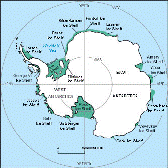Antarctic Drilling Program (ANDRILL)

ANDRILL Related Publications of Affiliates
Document Type
Article
Date of this Version
2007
Abstract
The evolution of Antarctic climate from a Cretaceous greenhouse into the Neogene icehouse is captured within a rich record of fossil leaves, wood, pollen, and flowers from the Antarctic Peninsula and the Transantarctic Mountains. About 85 million years ago, during the mid-Late Cretaceous, flowering plants thrived in subtropical climates in Antarctica. Analysis of their leaves and flowers, many of which were ancestors of plants that live in the tropics today, indicates that summer temperatures averaged 20°C during this global thermal maximum. After the Paleocene (~60 Ma) warmth-loving plants gradually lost their place in the vegetation and were replaced by floras dominated by araucarian conifers (monkey puzzles) and the southern beech Nothofagus, which tolerated freezing winters. Plants hung on tenaciously in high latitudes, even after ice sheets covered the land, and during periods of interglacial warmth in the Neogene small dwarf plants survived in tundra-like conditions within 500 km of the South Pole.


Comments
Published by Cooper, A. K., P. J. Barrett, H. Stagg, B. Storey, E. Stump, W. Wise, and the 10th ISAES editorial team, eds. (2008). Antarctica: A Keystone in a Changing World. Proceedings of the 10th International Symposium on Antarctic Earth Sciences. Washington, DC: The National Academies Press.doi:10.3133/of2007-1047.kp03